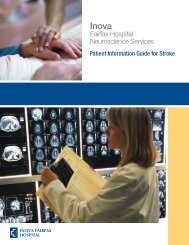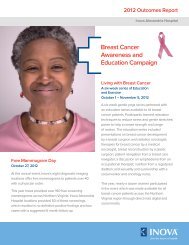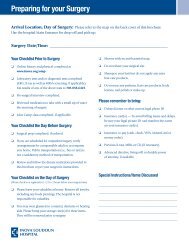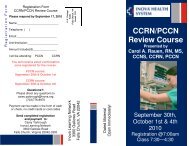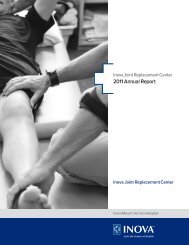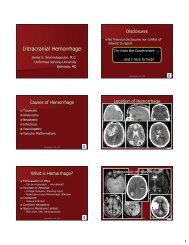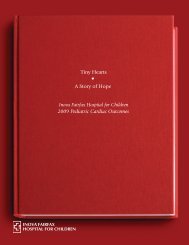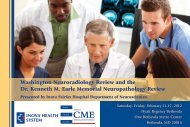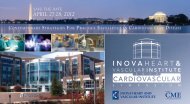Fungal and Parasitic Infections of the CNS - Inova Health System
Fungal and Parasitic Infections of the CNS - Inova Health System
Fungal and Parasitic Infections of the CNS - Inova Health System
You also want an ePaper? Increase the reach of your titles
YUMPU automatically turns print PDFs into web optimized ePapers that Google loves.
<strong>Fungal</strong> <strong>and</strong> <strong>Parasitic</strong><br />
<strong>Infections</strong> <strong>of</strong> <strong>the</strong> <strong>CNS</strong><br />
B.K. Kleinschmidt-DeMasters, MD<br />
Departments <strong>of</strong> Pathology, Neurology, Neurosurgery<br />
University <strong>of</strong> Colorado <strong>Health</strong> Sciences Center<br />
The content <strong>of</strong> this presentation does not<br />
relate to any product <strong>of</strong> a commercial<br />
interest; <strong>the</strong>refore, <strong>the</strong>re are no relevant<br />
financial relationship to disclose.<br />
Introduction<br />
• <strong>Fungal</strong> <strong>and</strong> parasitic infections are a<br />
somewhat difficult topic to underst<strong>and</strong><br />
beyond <strong>the</strong> “overview textbook” level due<br />
to <strong>the</strong><br />
– rarity <strong>of</strong> most <strong>of</strong> <strong>the</strong>se infections<br />
– selective geographic distribution<br />
– tendency <strong>of</strong> some <strong>of</strong> <strong>the</strong> fungal infections to<br />
affect restricted patients groups with<br />
various types <strong>of</strong> immunocompromising<br />
conditions<br />
1
Selective geographic distribution<br />
Most <strong>of</strong> <strong>the</strong> parasites <strong>and</strong> several <strong>of</strong> <strong>the</strong> fungi have predilections<br />
to affect individuals only in certain regions <strong>of</strong> world or <strong>the</strong> USA<br />
Paragonimiasis: south east Asia, Philippines, Indonesia, Papua New Guinea<br />
S. mansoni: tropical Africa, Saudi Arabia, South America<br />
S. japonicum: China, Philippines, Indonesia, Laos<br />
S. haematobium: Nile Valley, Africa<br />
Angiostrongylus cantonensis: south east Asia, Papua New Guinea, Pacific <strong>and</strong> Australia<br />
Histoplasma capsulatum: Ohio <strong>and</strong> Mississippi River Valleys<br />
Coccidioidomyces immitis: Argentina, Paraguay, Mexico, southwestern USA<br />
Tendency to affect select patient groups<br />
• This translates into underst<strong>and</strong>ing <strong>the</strong><br />
terms “pathogenic” versus “opportunistic”<br />
• Pathogenic= organism has <strong>the</strong> capability<br />
<strong>of</strong> producing disease in any individual,<br />
provided <strong>the</strong>y have INTERACTION WITH,<br />
AND EXPOSURE TO, sufficient numbers<br />
<strong>of</strong> organisms<br />
• Opportunistic= organism will only infect<br />
patients who have lowered resistance<br />
Opportunistic risk factors go beyond AIDS<br />
<strong>and</strong> organ transplantation<br />
2005 British Journal <strong>of</strong> Haematology, 129, 569–582<br />
2
Taxonomy simplified for <strong>the</strong> rest <strong>of</strong> us<br />
What does matter is whe<strong>the</strong>r fungi are yeasts (with or without<br />
pseudohyphae) versus hyphal forms (with or without septations)<br />
Yeasts are NOT vasoinvasive, hyphal forms ARE<br />
Taxonomy simplified<br />
Yeasts <strong>and</strong> yeast-like fungi<br />
Hyphal <strong>and</strong> pseudohyphal fungi<br />
NOT VASOINVASIVE<br />
Histoplasma<br />
Blastomyces<br />
Cryptococcus<br />
VASOINVASIVE<br />
C<strong>and</strong>ida<br />
Aspergillus <strong>and</strong> look-alikes<br />
Zygomyces<br />
Fusarium<br />
Coccidioides (sometimes)<br />
<strong>Fungal</strong> <strong>CNS</strong> infections are classic examples <strong>of</strong> <strong>the</strong><br />
BALANCE between host <strong>and</strong> organism<br />
HOST<br />
WINNING<br />
Focal confined<br />
infection<br />
Yeasts: granuloma<br />
Hyphae: granuloma<br />
FUNGAL ORGANISM<br />
WINNING<br />
Diffuse infection +/-<br />
vasoinvasive lesions<br />
Yeasts: meningitis<br />
Hyphae: meningitis +/-<br />
superimposed/ predominant<br />
hemorrhagic<br />
infarction/cerebritis<br />
3
An approach to <strong>CNS</strong> fungal infections<br />
Host immune status + Taxonomy simplified<br />
=pattern <strong>of</strong> disease<br />
+ morphology*<br />
= workable classification schema<br />
* H&E, me<strong>the</strong>namine silver, periodic acid Schiff<br />
(PAS), mucicarmine, [IHC]<br />
<strong>Fungal</strong> <strong>CNS</strong> <strong>Infections</strong>-from P to O*<br />
1. Blastomyces dermatitidis<br />
2. Histoplasma capsulatum<br />
3. Coccidioides immitis<br />
4. Cladosporium trichoides<br />
5. Aspergillus sp. + wannabees<br />
6. Rhizopus sp.<br />
7. C<strong>and</strong>ida sp. + look-alikes<br />
*pathogenic to opportunistic<br />
Blastomyces dermatiditis<br />
• Usually a PATHOGENIC INFECTION<br />
• Epidemiology: predominantly in North<br />
America, esp. sou<strong>the</strong>astern USA, lower<br />
Mississippi valley, <strong>and</strong> near sou<strong>the</strong>rn end<br />
<strong>of</strong> Lake Michigan. Called “Chicago disease”<br />
100 years ago<br />
• Even in endemic areas, incidence <strong>of</strong><br />
infection is LOW (?under-reported due to<br />
lack <strong>of</strong> national statistics; disease only<br />
reportable in 3 states: Illinois, Wisconsin,<br />
Mississippi)<br />
• Incidence <strong>of</strong> <strong>CNS</strong> infection extremely LOW<br />
4
Am J Surg Path 2007; 31:615-623<br />
Blastomyces dermatidis<br />
Lung-only involvement is most common<br />
Blastomyces dermatidis<br />
Lung-only involvement is most common<br />
5
Blastomyces dermatiditis<br />
<strong>CNS</strong> involvement uncommon:<br />
Usually is a localized granuloma with histiocytes <strong>and</strong> giant cells<br />
Even in disseminated disease, brain is involved in less than 1/3 <strong>of</strong><br />
patients<br />
Blastomyces dermatidis<br />
•Morphology <strong>of</strong> fungus<br />
–8-15 microns<br />
–Yeast with broad-based bud on<br />
GMS, PAS<br />
–In well-fixed tissues, blastomyces<br />
has multiple nuclei<br />
–Mucicarmine stain yields very<br />
thin outline to yeast, unlike broad,<br />
thick, mucicarmine +, mucoid<br />
capsule <strong>of</strong> Cryptococcus.<br />
Fontana-Masson also is positive<br />
on Cryptococcus capsule, but not<br />
in blastomyces<br />
From JB Taxy<br />
Histoplasma capsulatum<br />
• Usually a PATHOGENIC INFECTION, also with lungonly<br />
involvement<br />
– Benign illness confined <strong>and</strong> localized in lungs <strong>and</strong> mediastinal<br />
lymph notes; at autopsy small calcified nodules may be<br />
demonstrated in spleen, liver, <strong>and</strong> occasionally kidney but NOT<br />
<strong>CNS</strong><br />
– Active cavitating ti pulmonary lesion without t <strong>CNS</strong> involvement<br />
• Epidemiology: US midwest river valleys<br />
• Estimated that 25% <strong>of</strong> US population has contracted<br />
infection, but <strong>CNS</strong> involvement is uncommon.<br />
• Most common endemic mycosis in North America<br />
(followed by coccidiodomycosis <strong>and</strong> blastomycosis)<br />
6
Uncommon, localized granuloma in <strong>CNS</strong> histoplasmosis, as a<br />
surgical specimen, mimicking brain tumor in an<br />
immunocompetent host<br />
(from JJ Kepes)<br />
Histoplasma capsulatum<br />
• Occasionally an OPPORTUNISTIC INFECTION,<br />
with disseminated disease in<br />
immunocompromised patients<br />
– In infancy <strong>and</strong> childhood with lymphoreticular<br />
involvement <strong>and</strong> occasional basilar meningitis<br />
– In adults with caseous nodules in systemic organs<br />
<strong>and</strong> uncommon <strong>CNS</strong> infection (7%), which, when it<br />
does occur, is basilar meningitis<br />
– Disseminated disease may be AIDS defining illness<br />
Histoplasma capsulatum<br />
•Morphology <strong>of</strong> fungus<br />
–2-4 microns<br />
–Yeast usually<br />
intracellular within<br />
macrophages; PAS+ with<br />
slight halo around yeast<br />
BUT yeast does not have<br />
a real capsule<br />
–On H&E appear MUCH<br />
SMALLER THAN ON<br />
PAS or GMS because<br />
only <strong>the</strong>ir central portion<br />
is visible<br />
from JJ Kepes<br />
7
Coccidioides immitis<br />
• Usually PATHOGENIC infection, occasionally<br />
OPPORTUNISTIC<br />
• Epidemiology: Argentina, Paraguay, Mexico, southwestern<br />
USA<br />
• Pathogenic infection: mild febrile illness followed relatively<br />
frequently by lung infection which may be clinically overlooked<br />
• Predilection for <strong>CNS</strong>: Nervous system is involved in 1/3 <strong>of</strong><br />
cases even in non-immunocompromised hosts<br />
• Large granulomatous lesions rarely described but usually<br />
numerous small nodular granulomas occur at base <strong>of</strong> brain,<br />
necrotize <strong>and</strong> coalesce leading to basilar meningitis<br />
(granulomatous + purulent)<br />
• <strong>CNS</strong> vasoinvasion sometimes occurs<br />
Basilar<br />
meningitis<br />
Coccidioides immitis<br />
Coccidioides immitis<br />
• Morphology <strong>of</strong> fungus:<br />
-20-35 micron spherules (sporangia) containing endospores, seen<br />
easily on H&E, <strong>of</strong>ten in giant cells<br />
- PAS+ endospores<br />
- In nature, <strong>and</strong> exceedingly rarely in <strong>CNS</strong>, exist as hyphae with<br />
arthrospores<br />
8
Coccidioides immitis can be vasoinvasive under <strong>the</strong> right circumstances<br />
C. immitis in an AIDS patient<br />
Cladosporium trichoides<br />
• PATHOGENIC<br />
infection,<br />
occasionally<br />
OPPORTUNISTIC<br />
• Rare organism that<br />
causes multiple brain<br />
abscesses<br />
• PIGMENTED<br />
(dematiaceous),<br />
brown fungus on<br />
H&E<br />
• GMS shows budding<br />
yeast that elongate<br />
into hyphae with rare<br />
branching<br />
9
Aspergillus sp.<br />
• Usually OPPORTUNISTIC infection, only<br />
occasionally PATHOGENIC<br />
• When PATHOGENIC, Aspergillosis<br />
– usually involves one organ: lungs, paranasal<br />
sinuses, external ear<br />
– <strong>CNS</strong> involvement rare as pathogenic infection<br />
but has been described as isolated<br />
granulomas in immunocompetent patients<br />
ei<strong>the</strong>r from environmental exposure (farmers)<br />
or after brain surgery<br />
Aspergillus sp.<br />
• When OPPORTUNISTIC,<br />
– Usually spreads from lung to brain via<br />
bloodstream but rarely may extend directly<br />
from paranasal sinuses or orbit<br />
– Extent t <strong>of</strong> <strong>CNS</strong> involvement in<br />
OPPORTUNISTIC infection ranges<br />
considerably from one study to ano<strong>the</strong>r (60%)<br />
– Patient risk: steroid use, neutropenia<br />
10
Spectrum exists<br />
from bl<strong>and</strong> infarction<br />
due to vaso-occlusion<br />
to vaso-invasion<br />
with hemorrhagic<br />
cerebritis/abscesses;<br />
Within<br />
immunocompromised<br />
patients, DEGREE OF<br />
IMMUNOCOMPROMISE<br />
plays a role in DEGREE<br />
OF INVASIVENESS OF<br />
THE ORGANISM<br />
Hemorrhagic cerebritis from Aspergillus sp. in renal transplant recipient<br />
From JJ Kepes<br />
• Morphology:<br />
– Hyphae seen on H&E as<br />
radiating in corona-like fashion<br />
away from central thrombosed<br />
& destroyed blood vessel<br />
Organism capable <strong>of</strong> selectively<br />
destroying internal elastic<br />
lamina <strong>of</strong> cerebral vessels<br />
– Septate hyphae manifest<br />
uniform, acute angle (45 degree<br />
angle) dichotomous branching<br />
– In tissues, especially <strong>CNS</strong>,<br />
hyphae may be distorted <strong>and</strong><br />
bulbous, simulating o<strong>the</strong>r fungi<br />
such as Rhizopus sp.<br />
– Septations best seen on PAS<br />
– GMS stain may be overly dark<br />
Aspergillus sp<br />
11
Recognizing <strong>the</strong> role <strong>of</strong> <strong>the</strong> immune<br />
status <strong>of</strong> host makes fur<strong>the</strong>r sense<br />
because it influences…<br />
- <strong>the</strong> frequency <strong>of</strong> infection from various<br />
genus members within <strong>the</strong> same fungal<br />
species (ie., A. fumigatus vs. A. terreus)<br />
Aspergillus sp.<br />
• Most infections due to A. fumigatus, followed by A. flavus<br />
• Recently A. terreus has emerged as a pathogen in patients with<br />
solid tumors, especially those that involve <strong>the</strong> brain<br />
• Invasive aspergillosis is distinctly uncommon in patients with<br />
solid tumors, occurring in less than 1% <strong>of</strong> patients<br />
• Characteristic risk factors <strong>of</strong> pr<strong>of</strong>ound <strong>and</strong> prolonged<br />
neutropenia seen in hematologic cancer patients are not major<br />
risk factor in solid tumor patients<br />
• In patients t with solid tumors, corticosteroid t id use <strong>and</strong><br />
lymphopenia are dominant risk factors<br />
• In a small reported patient cohort, 7 <strong>of</strong> 13 patients (54%) with<br />
invasive aspergillosis had ei<strong>the</strong>r a primary or metastatic brain<br />
tumor as <strong>the</strong> underlying solid malignancy (Probably related to<br />
<strong>the</strong> large number <strong>of</strong> brain tumor patients requiring prolonged<br />
high dose corticosteroids for control <strong>of</strong> symptomatic peritumoral<br />
edema)<br />
• In series, 3 patients had aspergillosis brain infections <strong>and</strong> in 2<br />
patients <strong>the</strong> isolated Aspergillus species was A. terreus.<br />
A. Terreus<br />
ILLUSTRATIVE CLINICAL HISTORY<br />
• 60 year old female diagnosed<br />
6 months previously with left<br />
temporal lobe GBM.<br />
• Initial treatment for <strong>the</strong><br />
primary brain tumor<br />
consisted <strong>of</strong> gross total<br />
surgical resection with<br />
Gliadel® wafer placement,<br />
external beam irradiation,<br />
<strong>and</strong> two cycles <strong>of</strong> temozolomide.<br />
• Patient developed hallucinations<br />
<strong>and</strong> excess drowsiness; CT <strong>of</strong><br />
chest showed multifocal<br />
lung opacities.<br />
• 2 new brain lesions<br />
Interpreted as recurrent tumor;<br />
biopsy showed Aspergillus sp.;<br />
culture proven A.terreus.<br />
• Patient succumbed 6 days later.<br />
Both lesions – Non-contrast flair<br />
12
Aspergillus look-alikes<br />
• Cannot distinguish different Aspergillus species<br />
members<br />
• Pseudoallescheria boydii (Scedosporium<br />
apiospermum), Scedosporium inflatum,<br />
Chaetomium sp. are look-alikes<br />
– rarer than Aspergillus infections in <strong>the</strong> <strong>CNS</strong><br />
– indistinguishable clinically <strong>and</strong> pathologically<br />
– Proven by culture methods only<br />
– almost exclusively OPPORTUNISTIC infections<br />
Fusarium infections <strong>of</strong> <strong>CNS</strong><br />
• Ano<strong>the</strong>r Aspergillus look-alike<br />
• Epidemiology: soil<br />
saphrophyte<br />
• PATHOGENIC infection best<br />
documented in contact lens<br />
wearers<br />
• Rare <strong>CNS</strong>/ disseminated<br />
infections exclusively<br />
OPPORTUNISTIC<br />
• Morphology:<br />
– hyphal<br />
Zygomyces sp.<br />
• Almost exclusively OPPORTUNISTIC infection<br />
in <strong>CNS</strong><br />
• Epidemiology: classic emphasis on diabetic<br />
ketoacidosis, but also o<strong>the</strong>r acidotic or<br />
immunocompromised patients<br />
• Rhizopus>>>Mucor>>>>>>Absidia<br />
• Infection usually due to direct extension from<br />
infected nasal or paranasal infections, via <strong>the</strong><br />
orbit, NOT pulmonary infection<br />
13
Zygomyces sp.<br />
• Classic presentation: thrombosis <strong>of</strong> large<br />
cerebral vessels at base <strong>of</strong> brain, with<br />
subfrontal bl<strong>and</strong> infarctions<br />
• Ano<strong>the</strong>r vasoinvasive organism but in<br />
diabetics with ketoacidosis <strong>the</strong> organism is<br />
less invasive <strong>and</strong> vessel destructive (ie.,<br />
vessels are thrombosed but not destroyed,<br />
yielding infarcts)<br />
• Need to sample Circle <strong>of</strong> Willis vessels<br />
Zygomyces sp.<br />
from JJ Kepes<br />
Zygomyces infection: case history<br />
72 year old male with poorly<br />
differentiated lymphoma,<br />
who 10 days after receiving<br />
his last chemo<strong>the</strong>rapy<br />
developed transient right arm<br />
paralysis. On admission he<br />
was<br />
pancytopenic,<br />
hyperglycemia, acidotic,<br />
febrile, <strong>and</strong> had a pleural<br />
effusion. Despite aggressive<br />
measures, he succumbed 10<br />
days after admission. Both<br />
brain <strong>and</strong> lung infections<br />
were identified at autopsy.<br />
14
• Morphology:<br />
– Broad hyphae 10-15<br />
microns in diameter<br />
– Hyphae partially<br />
collapsed <strong>and</strong> distorted or<br />
twisted. Look almost<br />
artefactual on PAS, GMS<br />
– Folds may simulate<br />
septations<br />
– Branching irregular, in<br />
contrast to Aspergillus<br />
– Cross sections <strong>of</strong> large<br />
hyphae should not be<br />
mistaken for empty<br />
spherules <strong>of</strong> Coccidioides<br />
Zygomyces sp.<br />
Cryptococcus ne<strong>of</strong>ormans<br />
• Almost exclusively<br />
OPPORTUNISTIC infection<br />
in <strong>CNS</strong><br />
• Epidemiology: most<br />
common mycosis in AIDS<br />
patients; constitutes initial<br />
symptom <strong>of</strong> AIDS in up to<br />
26% <strong>of</strong> patients in older<br />
series<br />
• Severely<br />
immunocompromised<br />
patients: diffuse meningitis,<br />
with absent host<br />
inflammatory response<br />
• Localized infections<br />
(cryptococcomas) can be<br />
seen in some patients<br />
Cryptococcus ne<strong>of</strong>ormans<br />
• Almost exclusively<br />
OPPORTUNISTIC infection<br />
in <strong>CNS</strong><br />
• Epidemiology: most<br />
common mycosis in AIDS<br />
patients; constitutes initial<br />
symptom <strong>of</strong> AIDS in up to<br />
26% <strong>of</strong> patients in older<br />
series<br />
• Severely<br />
immunocompromised<br />
patients: diffuse meningitis,<br />
with absent host<br />
inflammatory response<br />
• Localized infections<br />
(cryptococcomas) can be<br />
seen in some patients<br />
15
Cryptococcus ne<strong>of</strong>ormans<br />
• Morphology:<br />
– 4-7 micron diameter yeast<br />
surrounded by 3-5 micron<br />
thick capsule (best seen on<br />
India ink preparation)<br />
– PAS <strong>and</strong> GMS show small<br />
budding yeasts; buds have<br />
short, narrow neck<br />
– Abundant capsule can form<br />
soap-bubble like lesions in<br />
tissue<br />
– Both cell wall <strong>and</strong> capsule<br />
stain with mucicarmine<br />
except in old, fibrotic,<br />
caseous, or poorly fixed<br />
tissues, when <strong>the</strong><br />
carminophilic staining is lost<br />
– Small forms overlap with<br />
Histoplasma, large with<br />
Blastomyces. Distinction<br />
comes with recognizing <strong>the</strong><br />
thick uniform capsule on<br />
mucicarmine stain<br />
C<strong>and</strong>ida sp.<br />
• Always OPPORTUNISTIC INFECTION<br />
• Epidemiology: normal gut flora that emerges as<br />
pathogen in patients with prolonged antibiotic<br />
<strong>the</strong>rapy, abdominal operations, ca<strong>the</strong>ters,<br />
diabetes, drug abuse, pediatric necrotizing<br />
enterocolitis<br />
• <strong>CNS</strong> lesions usually occur late in dissemianted<br />
disease<br />
• Corollary: C<strong>and</strong>idia infection is one <strong>of</strong> most<br />
common <strong>CNS</strong> fungal infections found at autopsy<br />
examination<br />
C<strong>and</strong>ida sp.<br />
• Morphology:<br />
– Pseudophyphae<br />
<strong>and</strong> chains <strong>of</strong> oval<br />
budding yeast 2-3<br />
microns<br />
– Vaso-invasive<br />
organism; hence<br />
<strong>CNS</strong> morphology<br />
is that <strong>of</strong><br />
hemorrhagic<br />
infarcts, numerous<br />
hemorrhagic<br />
necrotic lesions,<br />
<strong>and</strong> <strong>of</strong>ten little host<br />
immune response<br />
16
C<strong>and</strong>ida look-alikes<br />
• Torulopsis (C<strong>and</strong>ida)<br />
glabrata<br />
• Rhodotorula<br />
*distinguishable only by culture<br />
Conditions simulating fungal<br />
infection<br />
• Nocardia <strong>and</strong> actinomyces infections<br />
<strong>of</strong> <strong>CNS</strong><br />
– Caused by bacteria with branching,<br />
filamentous, THIN, appearance<br />
– Both are uncommon infections, but<br />
nocardiosis >> actinomycosis in frequency<br />
• Actinomycosis usually<br />
PATHOGENIC infection<br />
• Organisms normally exist<br />
in oral cavity or large<br />
intestine<br />
• Patient may have<br />
cervical-facial, thoracoabdominal,<br />
or dental<br />
infection<br />
• <strong>CNS</strong> infection results<br />
from hematogenous<br />
spread or direct<br />
extension from cervicalfacial<br />
infected focus<br />
• Gram +, “sulfur granules”<br />
(cohesive bacterial<br />
aggregates) in pus<br />
Actinomycosis<br />
17
Nocardiosis<br />
– Nocardiosis SHARES with most <strong>CNS</strong> fungal<br />
infections:<br />
• Ubiquitous organism<br />
• Pulmonary lesions (which may be clinically<br />
inconspicuous or resolved at <strong>the</strong> time <strong>of</strong> <strong>CNS</strong><br />
disease<br />
• Hematogenous spread to brain<br />
• Almost always an OPPORTUNISTIC INFECTION<br />
seen in severely immunosuppressed hosts: cancer<br />
patients, transplant recipients, AIDS<br />
• Ability to produce meningitis, abscesses or both<br />
Nocardiosis: case history<br />
57 year old male with mantle cell lymphoma,<br />
S/P autologous bone marrow transplant,<br />
followed by peripheral stem cell transplant<br />
which was complicated by graft versus host<br />
disease. The patient was found to have a right<br />
cerebellar mass, an abnormality in <strong>the</strong> right<br />
temporal lobe, <strong>and</strong> leptomeningeal<br />
enhancement by MRI; this was presumed to<br />
be involvement by his lymphoma <strong>and</strong> he was<br />
given whole brain radiation.<br />
Nocardiosis: case history<br />
Several days later he had a seizure <strong>and</strong> CT <strong>of</strong> <strong>the</strong> chest revealed multiple<br />
pulmonary nodules. He had a downhill course, developed a pontine<br />
infarction & hydrocephalus, neces-sitating placement <strong>of</strong> an external<br />
ventricular drain. He succumbed 4 months after admission. Autopsy was<br />
performed.<br />
18
Nocardia <strong>and</strong> Actinomyces<br />
• Morphology:<br />
– Both nocardia <strong>and</strong><br />
actinomyces are<br />
very thin; acid fast<br />
stain is supposed to<br />
differentiate <strong>the</strong> two<br />
but isn’t always that<br />
clear cut; culture is<br />
definitive<br />
– Gram stain +; GMS<br />
positive (improved<br />
with double length<br />
staining)<br />
• Sarcoid: granulomatous<br />
disease <strong>of</strong> unknown etiology,<br />
worldwide distribution<br />
• Lung most commonly<br />
involved organ; skeletal<br />
muscle <strong>and</strong> peripheral nerve<br />
also involved in significant %<br />
<strong>of</strong> patients; <strong>CNS</strong> involvement<br />
in 5% <strong>of</strong> cases<br />
• Pattern <strong>of</strong> disease in <strong>CNS</strong> is<br />
protean<br />
– meningeal, parenchymal,<br />
cranial nerve (esp. facial<br />
nerve),<br />
hypothalamic/pituitary<br />
involvement<br />
– Uncommon: myelopathy,<br />
intracranial dural mass<br />
simulating meningioma<br />
Neurosarcoidosis<br />
7 th inning stretch:<br />
Summary <strong>of</strong> <strong>CNS</strong> fungal infections<br />
• SOIL (except C<strong>and</strong>ida)<br />
• LUNG/BLOOD/BRAIN (except Rhizopus)<br />
• WORLDWIDE (except Blasto <strong>and</strong> Histo)<br />
• P to O spectrum: Blastomycosis (Y); Histoplasmosis (Y);<br />
Coccidioidomycosis (Y+ rare H); Cladosporiosis (H) ;<br />
Cryptococcosis (Y); Zygomycosis (H); C<strong>and</strong>idiasis (H)<br />
• Yeast vs. hyphal = pattern <strong>of</strong> <strong>CNS</strong> disease : granulomas<br />
as localized infections, meningitis +/-<br />
infarction/hemorrhagic cerebritis in diffuse severe<br />
infections<br />
19
<strong>CNS</strong> <strong>Parasitic</strong> infections<br />
Classification problems again…<br />
Classic taxonomy:<br />
Metazoal infections<br />
Nematodes<br />
Trematodes<br />
Cestodes<br />
Protozoal infections<br />
Amebiasis<br />
Cerebral malaria<br />
Toxoplasmosis<br />
Trypanomiasis<br />
<strong>CNS</strong> <strong>Parasitic</strong> infections simplified<br />
• All geographically relatively restricted<br />
EXCEPTIONS: cysticercosis, toxoplasmosis,<br />
<strong>and</strong> toxocariasis which are worldwide<br />
• Comes down to<br />
– Roundworms with w<strong>and</strong>ering larvae/worms<br />
(nematodes)<br />
– Flat flukes with w<strong>and</strong>ering egg-layers (trematodes)<br />
– Tapeworms with w<strong>and</strong>ering larvae (cestodes)<br />
– Protozoa with cellular size/intracellular location<br />
• Pathogenic to opportunistic range, just like fungi<br />
– All worms <strong>and</strong> flukes, <strong>and</strong> most protozoa, are P<br />
– Trypanosomiasis <strong>and</strong> toxoplasmosis P <strong>and</strong> occ. O<br />
<strong>CNS</strong> Metazoal infections: nematodes<br />
Nematodes (roundworms <strong>and</strong> filiaria)<br />
Toxocara canis (visceral larval migrans important<br />
for ocular/retinal infection)<br />
Trichinella spiralis usually affects skeletal muscle<br />
Onchocerca volvulus causes blindness in Africa<br />
Angiostrongylus cantonensis (rat lung worm) Far East, classically<br />
causes eosinophilic meningoencephalitis<br />
Strongyloides very rarely reported in immunosuppressed patients with<br />
suppressed cell-mediated immunity<br />
Loa loa subcutaneous <strong>and</strong> subconjunctival migration <strong>of</strong> adult worm<br />
SKIP THE ROUNDWORMS, not because <strong>of</strong> geography<br />
but because <strong>of</strong> infrequent <strong>CNS</strong> disease<br />
Image from:Scope Monograph <strong>of</strong> Pathoparasitolgy Color Atlas, Michael Kenney, MD ©1973<br />
20
<strong>CNS</strong> Metazoal infections:<br />
trematodes (flukes)<br />
• Schistosomiasis <strong>and</strong><br />
paragonimiasis<br />
seen in Africa or Asia<br />
• Paragonimiasis is lung fluke,<br />
Schistosomiasis is blood fluke.<br />
Mature flukes rarely seen in<br />
<strong>CNS</strong><br />
• Disease occurs when EGGS<br />
are deposited in <strong>CNS</strong> tissues<br />
by w<strong>and</strong>ering flukes, elicting<br />
granulomatous reaction<br />
Pathology <strong>of</strong> Tropical <strong>and</strong> Extraordinary Diseases<br />
Paragonimiasis<br />
Schistosomiasis<br />
Histology image from: Scope Monograph <strong>of</strong> Pathoparasitolgy<br />
Color Atlas, Michael Kenney, MD ©1973<br />
21
Schistosomiasis<br />
<strong>CNS</strong> Metazoal infections: cestodes<br />
Cestodes (Tapeworms)<br />
Echinococcus granulosus<br />
(Hydatid disease)<br />
Cysticercus cellulosae<br />
(neurocysticercosis)<br />
Key features: adult tapeworm is not<br />
<strong>the</strong> problem, <strong>the</strong> immature form is<br />
ECHINOCOCCUS:<br />
-dog is definitive host; adult<br />
tapeworm is in dog intestine<br />
-infection <strong>of</strong> man is from<br />
contamination <strong>of</strong> food by dog feces,<br />
frequent intimate contact with dogs +<br />
poor hygiene<br />
-Brain cyst (3% patients) usually<br />
solitary, unilocular, cerebral<br />
hemispheres<br />
American Journal <strong>of</strong> Neuroradiology 27:420-422, February 2006<br />
<strong>CNS</strong> Metazoal infections: cestodes<br />
• Cysticercosis is complicated by <strong>the</strong> fact<br />
that 2 diseases are possible in MAN:<br />
• The pig tapeworm Taenia solium remains<br />
intestinal in MAN<br />
• <strong>the</strong> larval stage Cysticercus cellulosae<br />
infects multiple systemic organs in MAN,<br />
<strong>the</strong> most important <strong>of</strong> which is <strong>the</strong> BRAIN<br />
22
Lifecycle<br />
Adult tapeworm<br />
Cysticercus in muscle<br />
<strong>System</strong>ic disease=<br />
cysticercosis<br />
• Parasite can be found in<br />
brain, muscle, eyes or skin<br />
• How <strong>the</strong> organism avoids<br />
<strong>the</strong> host immune system is<br />
largely unknown<br />
a) cyst with scolex in eye,<br />
b) calcifications on CT,<br />
c) MRI,<br />
d) pseudohypertrophy<br />
23
Neurocysticercosis<br />
Epidemiology<br />
• The most common<br />
parasitic <strong>CNS</strong> infection:<br />
50 million people<br />
infected<br />
• In certain areas, up to<br />
46% <strong>of</strong> population p is<br />
seropositive <strong>and</strong> 18%<br />
have calcifications on<br />
CT<br />
• NCC causes <strong>of</strong> 10% <strong>of</strong><br />
new seizures in areas <strong>of</strong><br />
Los Angeles <strong>and</strong> 6% in<br />
Albuquerque<br />
Prevalence Map<br />
• Most cases seen in <strong>the</strong><br />
US are import cases<br />
• Estimated that up to<br />
1000 new cases in US<br />
per year<br />
• A striking example is an<br />
outbreak in a orthodox<br />
Jewish community in<br />
New York in 1990<br />
Epidemiology, cont.<br />
<strong>CNS</strong> Parenchymal infection<br />
• The cysticercus develop a cyst ~10 mm with a thin wall <strong>and</strong> a<br />
scolex formation. No significant immune response<br />
• After a several (3-30) years <strong>the</strong> cyst starts degenerating. Wall<br />
thickens due to inflammation. Cyst fluid becomes denser<br />
• The cyst shrinks with an increasing surrounding immune<br />
response. This can take months to years<br />
• Finally <strong>the</strong> cyst resolves <strong>and</strong> is <strong>of</strong>ten replaced by a small<br />
calcification<br />
24
T1<br />
Diagnosis<br />
Radiology<br />
• Scolex is pathognomonic<br />
• Viable cysts are non enhancing, degenerating are enhancing<br />
• Calcifications<br />
CT<br />
T1 enhanced<br />
• Normally unattached <strong>and</strong><br />
can occasionally move<br />
between ventricles<br />
• Most frequently located in<br />
<strong>the</strong> fourth ventricle,<br />
followed by <strong>the</strong> third<br />
• Can block circulation <strong>of</strong><br />
cerebrospinal fluid<br />
Ventricular infection<br />
Picture from case<br />
CYSTICERCOSIS<br />
25
CYSTICERCOSIS<br />
CYSTICERCOSIS<br />
<strong>CNS</strong> Protozoal infections: Ameba<br />
• Entamoeba histolytica<br />
• Primary amebic encephalitis<br />
– Naeglia fowleria<br />
• Granulomatous amebic encephalitis<br />
– Acanthamoeba<br />
–Balmuthia<br />
26
Ameba<br />
• Entamoeba histolytica<br />
– Spread to brain via hematogenous route from liver or lung<br />
– <strong>CNS</strong> involvement rare; meningoencephalitis in 1-2% <strong>of</strong><br />
fatal cases<br />
– Trophozoites 15-25 microns, cysts are up to 25 microns<br />
<strong>and</strong> spherical with 4-8 nuclei<br />
• Naegleria fowleria<br />
– Free living waterborne ameba affecting previously health<br />
children <strong>and</strong> young adults esp. in summer <strong>and</strong> autumn<br />
months; swimming in warm lakes or pools<br />
– Protozoa enter <strong>CNS</strong> through nasal mucosa <strong>and</strong> cribriform<br />
plate<br />
– Trophozoities 10-20 microns; cysts never seen in tissues<br />
due to rapidly fatal course in patient<br />
• Granulomatous amebic encephalitis<br />
(Acanthamoeba/Balamuthia)<br />
- Trophozoites 15-45 microns; cysts 15-20 microns with<br />
wrinkled double wall<br />
Ameba<br />
27
Granulomatous amebiasis case<br />
history-Balamuthia<br />
12 year old male who had lived in Mexico until<br />
approximately 1 year prior to onset <strong>of</strong> medical problems.<br />
He first presented 1 ½ weeks prior to admission with<br />
severe emesis which persisted for 3 days <strong>and</strong> necessitated<br />
a visit to <strong>the</strong> ED at a hospital on <strong>the</strong> Western Slope <strong>of</strong><br />
Colorado. He was given antibiotics <strong>and</strong> discharged.<br />
Following this he developed diplopia, difficulty walking,<br />
<strong>and</strong> aphasia. An EEG was scheduled for possible petit mal<br />
seizures, but during <strong>the</strong> procedure he had a gr<strong>and</strong> mal<br />
seizure, with persistent altered mental status. MRI scan<br />
was performed which showed 9-12 ring-enhancing lesions<br />
<strong>and</strong> severe edema. CXR normal. Transferred for biopsy;<br />
died soon <strong>the</strong>reafter.<br />
GROSS BRAIN EXAMINATION<br />
HISTOLOGICAL EXAMINATION<br />
28
Balamuthia m<strong>and</strong>rillaris<br />
• Children 4 months to 23 years<br />
affected by free living soil ameba,<br />
immunodeficiency has not clearly<br />
played a role in pediatric cases<br />
versus adults<br />
• Can be definitively differentiated<br />
from Acanthamoeba only by<br />
antibodies<br />
• Responsible for sporadic<br />
meningoencephalitis with<br />
mortality rates near 100%<br />
• 2001: About 200 cases reported<br />
worldwide.<br />
• Spreads hematogenously from<br />
cutaneous, ocular, or pulmonary<br />
lesion to <strong>the</strong> <strong>CNS</strong><br />
• In <strong>CNS</strong>, vasculitis dominates<br />
clinical picture<br />
• Death within 6-8 weeks <strong>of</strong><br />
diagnosis<br />
<strong>CNS</strong> Protozoal infections: Malaria<br />
• <strong>CNS</strong> involvement seen<br />
with only one species,<br />
Plasmodium falciparum<br />
• Mortality in some parts <strong>of</strong><br />
<strong>the</strong> world 20-50%,<br />
especially infants <strong>and</strong><br />
children<br />
• Well-nourished individuals<br />
more susceptible than<br />
malnourished ones in<br />
Africa, related to body iron<br />
status<br />
• Infection common in<br />
pregnancy, possibly<br />
related to relative<br />
immunosuppression<br />
• Steroid administration<br />
predisposes to severe<br />
infection: A TOUCH OF O<br />
<strong>CNS</strong> Protozoal infections:<br />
Trypanosoma brucei & cruzi<br />
• African T. brucei<br />
• South American<br />
trypanosomiasis<br />
(Chagas disease) commonly<br />
involves autonomic nervous<br />
system, cause <strong>of</strong> <strong>the</strong> underlying<br />
megasyndromes. Protozoa has<br />
proclivity for infecting muscle<br />
– <strong>CNS</strong> involvement clinically<br />
not common<br />
– Acute form <strong>of</strong> disease<br />
occurs in children under<br />
age 1 yr.; protozoa infects<br />
astrocytes <strong>and</strong> endo<strong>the</strong>lium<br />
<strong>of</strong> cerebral blood vessels<br />
– Chronic form occurs in<br />
10% <strong>of</strong> cases<br />
– Disease well known to be<br />
severe in patients with<br />
AIDS <strong>and</strong> as a congenital<br />
disease, underscoring P+O<br />
biology <strong>of</strong> some protozoa<br />
29
<strong>CNS</strong> Protozoal infections:<br />
Toxoplasma gondii<br />
• Worldwide; occurs following ingestion <strong>of</strong> oocysts<br />
shed in cat feces<br />
• Depending on geographic region, 3-50% <strong>of</strong><br />
population has antibodies<br />
• PATHOGENIC infection frequent: infectious<br />
mononucleosis-like illness, febrile illness with<br />
maculopapular rash<br />
• <strong>CNS</strong> involvement almost always an<br />
OPPORTUNISTIC infection; <strong>CNS</strong> involvement<br />
major complication <strong>of</strong> disseminated disease in<br />
AIDS <strong>and</strong> congenital cases<br />
<strong>CNS</strong> Protozoal infections: Toxoplasma gondii<br />
<strong>CNS</strong> disease takes <strong>the</strong> form <strong>of</strong> abscesses, with acute necrotizing,<br />
organizing, <strong>and</strong> chronic forms recognized<br />
<strong>CNS</strong> Protozoal infections: Congenital toxoplasmosis<br />
Destructive, cavitating<br />
process in immature fetal<br />
brain, with minimal<br />
inflammatory reaction &<br />
dystrophic mineralization:<br />
organisms difficult to<br />
demonstrate at this stage<br />
30
cysticercosis, toxoplasmosis,<br />
<strong>and</strong> toxocariasis are worldwide<br />
The Closer:<br />
<strong>Parasitic</strong><br />
<strong>Infections</strong><br />
- Roundworms with w<strong>and</strong>ering<br />
larvae/worms (Toxocariasis)<br />
- Flat flukes with w<strong>and</strong>ering egglayers<br />
(Schistosomiasis)<br />
- Tapeworms with w<strong>and</strong>ering larvae<br />
(Cysticercosis)<br />
- Protozoa with cellular<br />
size/intracellular location (Malaria,<br />
Toxoplasmosis)<br />
- Pathogenic to opportunistic range, just<br />
like fungi<br />
- All worms <strong>and</strong> flukes, <strong>and</strong> most<br />
protozoa, are P<br />
- Trypanosomiasis <strong>and</strong> toxoplasmosis<br />
P <strong>and</strong> occ. O<br />
31




